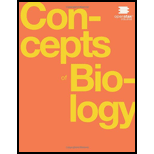
Concept explainers
Figure 3.7 What structures does a plant cell have that an animal cell does not have? What structures does an animal cell have that a plant cell does not have?

Figure 3.7 This figure shows (a) a typical animal cell and (b) a typical plant cell.
To analyze:
The similar characteristics and different features of plant cells and animal cells.
Introduction:
Both plant cells and animal cells are eukaryotic cells and have some common features. The plasma membrane, cytoplasm, nucleus, mitochondria, endoplasmic reticulum, Golgi apparatus, and ribosomes are the structures present in both plant and animal cells. Besides these structures some structures such as chloroplast, cell wall, a central vacuole are exclusively present in plant cell and similarly centrosomes, centrioles and lysosomes are present only in animal cells.
Explanation of Solution
A typical plant cell possesses a cell wall, plasmodesmata, a large central vacuole, chloroplasts, and other plastids. These structures are absent in animal cells. The cell wall is a rigid covering which protects plant cells and gives structural support to the plant cells. Plasmodesmata are the channels which connect cell to cell and involves in the transportation of materials. The water in plant cells is regulated by the central vacuole. Chloroplasts are responsible for photosynthesis in plant cells.
A typical animal cell has centrosomes which have centrioles and lysosomes. These structures are not present in the plant cells. Centrosomes are located in the microtubules and function as the organizing center. The centrioles present in them have an unknown role in the process of cell division. Lysosomes perform the function of waste disposal and contain hydrolytic enzymes for digestion.
A plant cell possesses a cell wall, plasmodesmata, a large central vacuole, chloroplasts and plastids. These structures are absent in animal cells. A animal cell has centrosomes which have centrioles and lysosomes. These structures are absent in the plant cells.
Want to see more full solutions like this?
Chapter 3 Solutions
Concepts of Biology
Additional Science Textbook Solutions
College Physics
Microbiology: An Introduction (13th Edition)
Microbiology: An Introduction
Biological Science (6th Edition)
Campbell Biology in Focus (2nd Edition)
Microbiology with Diseases by Body System (4th Edition)
- Figure 3.13 Why does the cis face of the Golgi not face the plasma membrane?arrow_forwardThe eukaryotic cell in the photo on the left is in the process of cytoplasmic division. Is this cell from a plant or an animal? How do you know?arrow_forwardthe cells of the aquatic plant Elodea. Name the rounded green organelles in this photo. Name the pigment that makes them look green. What is the function of these organelles in the cell? Based on a video showing motion in the cells of the Elodea leaf, describe this motion.arrow_forward
- difference between plant and animal cellarrow_forwardList 5 parts of a eukaryotic animal cell and provide a clear explanation of the function of each cell part List 5 parts of a eukaryotic plant cell and provide a clear explanation of the function of each cell part.arrow_forwardIdentify one component of the cell. Describe the structural appearance using your own words Explain the function of the structure. Show a relationship between your component and another structure that it can possibly work with Describe what would happen to the cell if your structure is missing or damaged.arrow_forward
- After each description, fill in the appropriate structure: “powerhouses” of the cell:_______ ; capture solar energy: _______; structure outside of animal cells:_________; region of prokaryotic cell containing DNA:________; propel fluid past cells:_________ ;consists of the cytosol and the organelles within it:arrow_forwarddraw the cells in the given imagearrow_forwardCompare the structures of animal and plant cells. How are they different? How are they the same? (Minimum of three similarities and three differences)arrow_forward
- The main difference between plant and animal cells is: A Plant cells has small vacuoles B Animal cell lacks rigid cell wall C Animal cells has large vacuoles D Plant cell lacks rigid cell wallarrow_forwardComparing Plant Cell and Animal Cell Bases of Comparison Plant Cell Animal Cell Cell Wall Vacuoles Centrioles Plastids Cytoskeletonarrow_forwardWhy does nucleus is more important among other cellarrow_forward

 Biology 2eBiologyISBN:9781947172517Author:Matthew Douglas, Jung Choi, Mary Ann ClarkPublisher:OpenStax
Biology 2eBiologyISBN:9781947172517Author:Matthew Douglas, Jung Choi, Mary Ann ClarkPublisher:OpenStax Biology Today and Tomorrow without Physiology (Mi...BiologyISBN:9781305117396Author:Cecie Starr, Christine Evers, Lisa StarrPublisher:Cengage Learning
Biology Today and Tomorrow without Physiology (Mi...BiologyISBN:9781305117396Author:Cecie Starr, Christine Evers, Lisa StarrPublisher:Cengage Learning Concepts of BiologyBiologyISBN:9781938168116Author:Samantha Fowler, Rebecca Roush, James WisePublisher:OpenStax College
Concepts of BiologyBiologyISBN:9781938168116Author:Samantha Fowler, Rebecca Roush, James WisePublisher:OpenStax College



